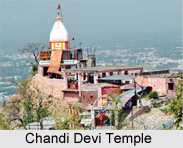 Chandika Devi Temple is of the Valabhi temples located in Uttarakhand in the Almora District of North India. A small group of temples known as Kubera, is situated on a hill slope to the North East of the main temples of Jageshvara and the Jata Ganga on the right side. One of the temples of this group is the Chandika Devi Temple. The temple faces westward. Based on the stylistic grounds the Chandika Devi Temple can be dated back to the early ninth century A.D.
Chandika Devi Temple is of the Valabhi temples located in Uttarakhand in the Almora District of North India. A small group of temples known as Kubera, is situated on a hill slope to the North East of the main temples of Jageshvara and the Jata Ganga on the right side. One of the temples of this group is the Chandika Devi Temple. The temple faces westward. Based on the stylistic grounds the Chandika Devi Temple can be dated back to the early ninth century A.D.
Structure of Chandika Devi Temple
The Chandika Devi temple houses a rectangular garbabriha and a simple antarala or kapila. The external and internal measurements of the garbagriha and kapila are noted as 1.75 x 1.45m and 1.0 x 0.75m and 33.5x1.23m and 0.62x 0.80m respectively.
The height of Chandika Devi Temple is almost about 3.5m. This famous Valabhi temple has been constructed on a simple jagati pitha. The elevation plan of the temple consists of an adhisthana that is raised by three bhittas, dvi-anga, vedibandha, jangha and shikhara. The vedibandha is Khura, Kumbha, Kalasa, Kapotapali and plain Pattika. The parsvas of the bhadra bhaga of the jangha appear like a plain rathika thet is adorned with two ardha stambhas. The plain pathika is placed over the jangha.
The shikhara of the Chandika Devi Temple is of a misraka type that appears to be elevated in three parts. The first khanda which is the lowest one comprises of an amalaka on karnabhaga. This is based on the jangha. A pseudo shikhara has been positioned over the bhadrabhaga of the back. Both the parsvasare that is designed with simple small gavaksasor chandrasalas almost touches the lower half of the Valabhi. An amalaka has been placed on the top of the shikhara. The second part is based on the above. The Skandadevi has a huge chandrasala and is surmounted by a simple Valabhi. It has chandrasa decoration on its either parsvas. Two simhas sitting back to back are placed over the Valabhi. Presently At present only one of them can be seen..
The sukhanasa that has been placed on the antaralaor kapila is divided by a simple antarpatra in two parts, Skandhavedi and half Valabhi. A prominent swamukha is shown within the gavasa of the upper portion.





















